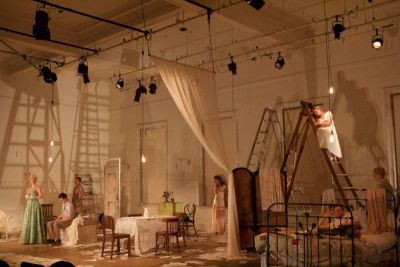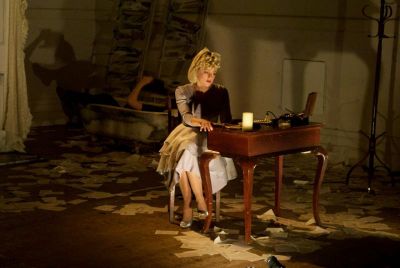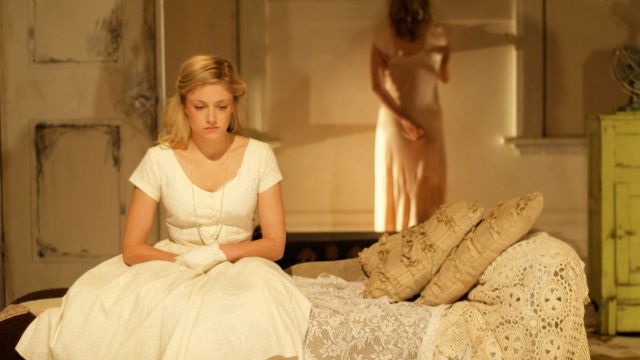Project: Hysteria
Heat, sweat, languor and frustrated – or arrested – sexuality in a 1930s ‘south’ of the USA. That’s the immediate and powerful impression on entering the theatre. We know the show is by Tennessee Williams, so we’re primed. The wide playing space – with iconic period furniture in pools of light and naked hanging bulbs - occupies fully half of the Trades Hall ballroom. The cast, in costume and in various poses, are already on stage. A neatly dressed young fellow stands rigid to one side. A woman in a clinging negligee tosses and turns on a chaise longue. A muscular man lies on a rumpled brass bed, his braces over his dirty singlet. A heavily pregnant woman scutters about distractedly. An older woman, headscarf over curlers, obsessively checks her make-up. Upstage, a girl in a white dress perches on a tall ladder, in her own world. On another ladder, a young man with a moustache and bow tie – an uncanny resemblance to Tennessee himself – reaches out for one of the hanging bulbs… and the show begins. This vision, before the plays themselves have even begun, is a triumph by director Alister Smith and lighting designer Daniel Chapman. And it is in its images and in the visual use and disposition of the cast that the strengths of this production lie.
 Both of the plays has a cast of four, but all eight actors remain on stage. As one play is enacted, the other four cast move like silent ghosts and suggest the subtext or the darker, more Gothic or more ‘hysterical’ motives of the characters. This imaginative device at times works extremely well, signifying a whole other meaning to the surface text. At other times, however, is can be a puzzling distraction – especially when an actor is glimpsed out of the corner of one’s eye, moving at the other end of the very wide space.
Both of the plays has a cast of four, but all eight actors remain on stage. As one play is enacted, the other four cast move like silent ghosts and suggest the subtext or the darker, more Gothic or more ‘hysterical’ motives of the characters. This imaginative device at times works extremely well, signifying a whole other meaning to the surface text. At other times, however, is can be a puzzling distraction – especially when an actor is glimpsed out of the corner of one’s eye, moving at the other end of the very wide space.
Play one is The Pretty Trap - i.e. what women are, by necessity, to men, according to the despairing Mama as she explains harsh reality to her reclusive daughter. The play is a forerunner or tryout for the famous The Glass Menagerie. Described as ‘light comedy’ – it has a happy ending anyway and has elements of sit-com - it runs only about 45 minutes and as a play per se it’s not that great. The plot – up to the ‘happy ending’ anyway - is pretty much the same, but here painfully shy Laura (Jessica Redmayne) is unexpectedly and rather easily won over by ‘gentleman caller’ Jim (Eddie Orton in another assured performance) much to the delight and relief of Mama Amanda (Trudi Boatwright).
We guess that in the interim between The Pretty Trap and Menagerie Tennessee Williams discovered subtlety, subtext and economy – and then went on to work with Elia Kazan on Streetcar. But Mr Smith and his cast find the darkness and despair in these preparatory scenarios. In performance, if not in text, it’s clear that brother Tom (Damien Harrison) desires the oblivious Jim himself. As Tom disappears from the situation (he is no more than a plot device in the text), he retires to his ladder again – i.e. the observer – i.e. Tennessee. Notably, in Menagerie, the tale is told from Tom’s Point of View.
 Then, undercutting the ‘romantic’ ending, in which Laura and Jim go for ‘a walk’, there’s a counterpoint during the playing of the second play Interior: Panic: in dim light, behind the play per se, Laura and Jim have rough, urgent sex on the chaise longue. The point is perfectly clear, but no less powerful for that: sweet, pretty ‘romance’ is driven by sexual desire.
Then, undercutting the ‘romantic’ ending, in which Laura and Jim go for ‘a walk’, there’s a counterpoint during the playing of the second play Interior: Panic: in dim light, behind the play per se, Laura and Jim have rough, urgent sex on the chaise longue. The point is perfectly clear, but no less powerful for that: sweet, pretty ‘romance’ is driven by sexual desire.
Interior: Panic is a precursor to A Streetcar Named Desire – probably the best known of all Williams’ plays. All the characters’ names except ‘Blanche’ are different, but the situation is immediately recognisable. Harassed, pregnant Grace (a lovely restrained performance from Fleur Murphy) is the peacekeeper between her sister Blanche (Annie Last) and her husband, butch working man Jack (Vaughn Rae). Mr Rae has a great physicality and that always fascinating characteristic of barely restrained rage. George (Luke Cadden) is the gentleman caller here and he manages to be both bland and menacing. It is Blanche who is in a state of panic, hiding out, terrified that her past is about to catch up with her, fearful of going mad.
 With all this impressive and original theatrical imagination and some excellent performances on show, it is unfortunate that the acoustics of the space, the well chosen but too loud music, the struggle with ‘southern’ accents and a propensity to suggest ‘hysteria’ by excess - gabbling and twitching - all tend to overcome the text. In The Pretty Trap, Ms Boatwright as Mama Amanda looks perfect and has great presence, but she has some big speeches, and not only does ‘hysteria’ feel imposed on what might be comic, much meaning is simply lost. With Interior: Panic, it’s just about impossible not to remember Vivien Leigh as Blanche in the movie: she never once raises her voice or rolls her eyes and yet she is eerily, pathetically disturbed. Ms Last as this Blanche is perfectly cast – seductive, sensual, radiating overwhelming anxiety with every move – but she suffers much the same fate as to audibility and clarity. Too bad, since these ‘arias’ carry the central burden of Williams’ texts.
With all this impressive and original theatrical imagination and some excellent performances on show, it is unfortunate that the acoustics of the space, the well chosen but too loud music, the struggle with ‘southern’ accents and a propensity to suggest ‘hysteria’ by excess - gabbling and twitching - all tend to overcome the text. In The Pretty Trap, Ms Boatwright as Mama Amanda looks perfect and has great presence, but she has some big speeches, and not only does ‘hysteria’ feel imposed on what might be comic, much meaning is simply lost. With Interior: Panic, it’s just about impossible not to remember Vivien Leigh as Blanche in the movie: she never once raises her voice or rolls her eyes and yet she is eerily, pathetically disturbed. Ms Last as this Blanche is perfectly cast – seductive, sensual, radiating overwhelming anxiety with every move – but she suffers much the same fate as to audibility and clarity. Too bad, since these ‘arias’ carry the central burden of Williams’ texts.
It’s disappointing then that these miscalculations mar such wonderful theatricality and images redolent with darkness, sadness and desire. Mr Smith is clearly a talented director to watch. But here and with other shows, I can’t help wondering whether the director has sat down, not just in the good seats but all over, and checked sightlines and clarity. It would help.
Michael Brindley
Images (from top) : Jessica Redmayne and Annie Last; Fluer Murphy and Annie Last; Trudy Boatwright, Damien Harrison (seated), Edward Orton, Annie Last, Jessica Redmayne (on ladder), Vaughn Rae & Fleur Muprhy; Trudy Boatwright. Photographer: Myles Tankle.
Subscribe to our E-Newsletter, buy our latest print edition or find a Performing Arts book at Book Nook.

